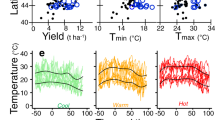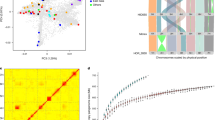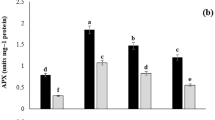Summary
The associations of alleles at different electrophoretic loci observed in barley and wild oats can be explained by hitch-hiking due to the mating system. In other words, selection at other loci in the genome may have resulted in gametic disequilibrium or a change in gametic disequilibrium at neutral loci in these highly self-fertilised plants. This explanation appears to be a simple alternative hypothesis to account for the change in gametic disequilibrium in barley and the presence of gametic disequilibrium in wild oats. However, it appears difficult to differentiate experimentally between the hitch hiking and the previously proposed coadaptation hypotheses.
Similar content being viewed by others
Article PDF
References
Allard, R W, Babbel, G R, Clegg, M T, and Kahler, A L. 1972a. Evidence for coadaptation in Avena barbata. Proc Nat Acad Sci, 69, 3043–3048.
Allard, R W, and Jain, S K. 1962. Population studies in predominately self-pollinated species. II. Analysis of quantitative genetic changes in a bulk-hybrid population of barley. Evolution, 16, 90–101.
Allard, R W, Kahlek, A L, and Weir, B S. 1972b. The effect of selection on esterase allozymes in a barley population. Genetics, 72, 489–503.
Bennett, J H. 1954. On the theory of random mating. Ann Eugenics, 18, 311–317.
Bennett, J H, and Binet, F E. 1956. Association between Mendelian factors with mixed selling and random mating. Heredity, 44, 5–13.
Clegg, M T, and Allard, R W. 1972. Patterns of genetic differentiation in the slender wild oat species Avena barbata. Proc Nat Acad Sci, 69, 1820–1824.
Clegg, M T, Kahler, A L, and Allard, R W. 1978. Estimation of life cycle components of selection in an experimental plant population. Genetics, 89, 765–792.
Cockerham, C C, and Rawlings, J D. 1967. Apparent heterosis of a neutral gene with inbreeding. Ciencia E Culture, 19, 89–94.
Hamrick, J L, and Allard, R W. 1972. Microgeographical variation in allozyme frequencies in Avena barbata. Proc Nat Acad Sci, 69, 2100–2104.
Hamrick, J L, and Allard, R W. 1975. Correlations between quantitative characters and enzyme genotypes in Avena barbata. Evolution, 29, 438–442.
Hedrick, P W. 1979. Hitchhiking: A comparison of linkage and partial selfing. Genetics (in press).
Hedrick, P W, Jain, S, and Holden, L. 1978. Multilocus systems in evolution. Evolutionary Biology, 11, 101–184.
Holden, L R. 1979. New properties of the two-locus partial-selfing model with selection. Genetics (in press).
Jain, S K, and Marshall, D R. 1967. Population studies in predominantly self-pollinating species. X. Variation in natural populations of Avena fatua and A. barbata. Amer Natur, 101, 19–33.
Kojima, K, and Schaffer, H E. 1967. Survival process of linked mutant genes. Evolution, 21, 518–531.
Lewontin, R C. 1974. The Genetic Basis of Evolutionary Change. Columbia, New York.
Maynard Smith, J, and Haigh, J. 1974. The hitch-hiking effect of a favorable gene. Genet Res, 23, 23–35.
Nei, M. 1975. Molecular Population Genetics and Evolution. North Holland Publ. Co., Amsterdam.
Ohta, T, and Cockerham, C C. 1974. Detrimental genes with partial selfing and effects on a neutral locus. Genet Res, 23, 191–200.
Ohta, T, and Kimura, M. 1975. The effect of selected linked locus on heterozygosity of neutral alleles (the hitch-hiking effect). Genet Res, 25, 313–326.
Thomson, G. 1977. The effect of a selected locus on linked neutral loci. Genetics, 85, 753–788.
Wagener, D K, and Cavalli-Sforza, L L. 1975. Ethnic variation in genetic disease: Possible roles of hitchhiking and epistasis. Amer J Hum Genet, 27, 348–364.
Weir, B S, Allard, R W, and Kahler, A L. 1972. Analysis of complex allozyme polymorphisms in a barley population. Genetics, 72, 505–523.
Weir, B S, and Cockerham, C Clark. 1973. Mixed self and random mating at two loci Genet Res, 21, 247–262.
Author information
Authors and Affiliations
Rights and permissions
About this article
Cite this article
Hedrick, P., Holden, L. Hitch-hiking: An alternative to coadaptation for the barley and slender wild oat examples. Heredity 43, 79–86 (1979). https://doi.org/10.1038/hdy.1979.61
Received:
Issue date:
DOI: https://doi.org/10.1038/hdy.1979.61
This article is cited by
-
Pattern and variation in simple sequence repeat (SSR) at different genomic regions and its implications to maize evolution and breeding
BMC Genomics (2023)
-
Epistasis in natural populations of a predominantly selfing plant
Heredity (2011)
-
Hybridization, recombination, and the genetic basis of fitness variation across environments in Avena barbata
Genetica (2007)
-
Plant genetic adaptedness to climatic and edaphic environment
Euphytica (1996)
-
Colonization history and population genetic structure of Eichhornia paniculata in Jamaica
Heredity (1991)



